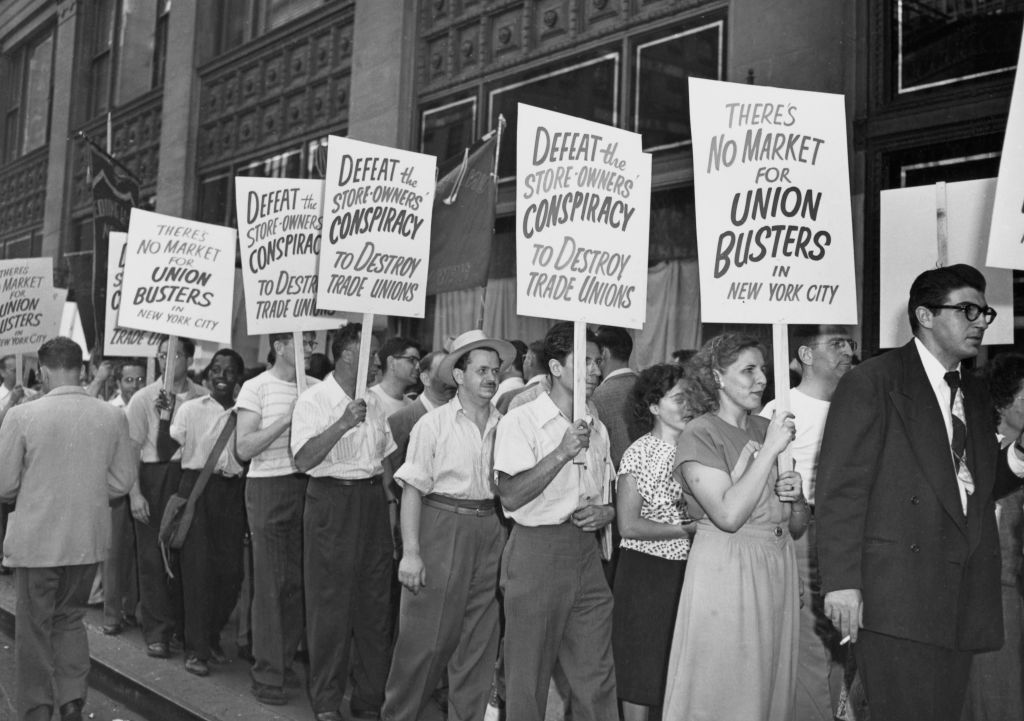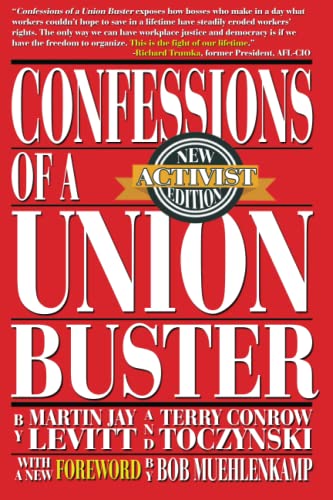Inside the Secretive World of Union Busting
Inside the Secretive World of Union Busting: The Story of an Unlikely Alliance
Thirty years ago, a labor organizer helped convince an anti-union consultant to document his methods.

They were certainly an odd couple, the unlikeliest of allies: the union organizer and the notorious union buster. Bob Muehlenkamp, a stalwart of the modern-day labor movement, has coordinated hundreds of union organizing campaigns and was the organizing director of the Teamsters and SEIU 1199, the hospital workers union. Martin Jay Levitt, a master of corporate skulduggery, did everything he could as a consultant hired by hundreds of companies to intimidate workers into not joining a union. Once, during an organizing effort marked by threats of violence at one of the country’s biggest hospital systems, Muehlenkamp was handcuffed and arrested for trespassing, Levitt relishing another victory as employees voted not to join a union. They were on opposite sides, fighting tooth and nail, for close to 20 years.
 Until Levitt had a change of heart, and in the late 1980s reached out to Muehlenkamp about his desire to write a book exposing the dirty tricks of the union-busting industry. Levitt’s Confessions of a Union Buster was published in 1993 and immediately made waves, with Levitt appearing on 60 Minutes and giving lectures around the country to denounce his former colleagues and confess his sins. “Union-busting is a field populated by bullies and built on deceit,” he wrote. “The only way to bust a union is to lie, distort, manipulate, threaten and always, always attack.” He described how his former firm, Modern Management Methods, had developed a methodology for breaking down employee support for unions by using psychological tactics and turning managers into anti-union spokespersons.
Until Levitt had a change of heart, and in the late 1980s reached out to Muehlenkamp about his desire to write a book exposing the dirty tricks of the union-busting industry. Levitt’s Confessions of a Union Buster was published in 1993 and immediately made waves, with Levitt appearing on 60 Minutes and giving lectures around the country to denounce his former colleagues and confess his sins. “Union-busting is a field populated by bullies and built on deceit,” he wrote. “The only way to bust a union is to lie, distort, manipulate, threaten and always, always attack.” He described how his former firm, Modern Management Methods, had developed a methodology for breaking down employee support for unions by using psychological tactics and turning managers into anti-union spokespersons.
His new career as a reformer earned him enemies on both sides — panicking his old colleagues in the union avoidance consulting industry and arousing skepticism among former nemeses in the labor movement, one of whom called him a “cheesy hustler.”
Levitt wrote about his insatiable greed, his alcoholism, a rap sheet that included forgeries, check fraud and arson, and multiple illegal activities on behalf of some of America’s biggest companies. Critics called him an opportunist, but some labor veterans, including Muehlenkamp, saw him as an important ally who could help them learn how to combat the union busters.
Levitt was a complicated penitent — just months after the book was published, he went to jail for obtaining credit by false pretenses — and he passed away in 2004 without having won over that many of his former antagonists.
But his seminal book has served as a guide for union organizers and their allies. Levitt describes how his former industry benefited enormously from a 1950s-era loophole in labor law that allowed companies to hire anti-union consultants without disclosing those arrangements — one of the “enormous, gaping errors in the law that have left room for a sleazy billion-dollar industry to plod through,” Levitt wrote. That loophole was closed in 2016 by the Department of Labor, finally shedding light on an industry paid an estimated $340 million a year by companies. The labor victory was short-lived — just a few years later, the loophole was reopened by the Trump administration, and the Biden administration has yet to take action.
The book is being reprinted, with a new introduction and appendix by Muehlenkamp, who writes that “it documents the dirty underside of how U.S. corporations, who routinely bargain with unions in other countries, attacked and weakened American democracy. The question is, what can we do about it? We know how to have the best chance at beating the union busters. It starts with reading Levitt’s book. Know the enemy and take them as seriously as they take a union.”
Muehlenkamp talked to Capital & Main about his experiences in the movement, knowing Levitt as enemy and ally, and what he sees as the biggest challenges facing unions today.
Note: This interview has been edited for length and clarity.
Capital & Main: What motivated you to write the intro? Were you familiar with Confessions of a Union Buster?
I knew Marty and I encouraged him to write it. He came to me and asked me if I thought it would be worth doing.
Now, it’s been over 25 years, but it’s relevant at this moment and we thought it would be right, both in terms of people wanting to organize and in terms of democracy and what’s happening in the country, to come out with a new edition of the book. It’s almost impossible to have a vibrant democracy without the labor movement. It just doesn’t work.
So take me back to how you first met Levitt.
I first met Marty during the organizing effort at Henry Ford Hospital [in southwest Detroit] back in 1972-73. It was and maybe still is the biggest union election in any private hospital. Henry Ford was 2,800 [workers eligible to be unionized]. They stacked it. Originally it was 1,300. They stacked it with 1,500 more workers — secretaries and others [which makes it harder for the union to win elections], and then they proceeded to unleash, for the first time in my experience, the full campaign. To the extent that even the organizers had surveillance on us. All the time. I’d never experienced that level of intensity before, and I’d been organizing workers for about three years. They delayed until they were ready. They stacked the list. They eliminated all the leaders through intimidation or firing them. They isolated everyone. They had relentless communication, based on psychological methods. They arrested me, just to portray “violent” union organizers, for trespassing.
“It’s almost impossible to have a vibrant democracy without the labor movement. It just doesn’t work.”
What happened?
I was inside the hospital talking to workers. It’s a vast complex, and I’m just talking with some workers. And of course they surveilled me and walked up and put cuffs on me for trespassing, and I was booked.
And did you encounter Levitt during that battle?
Never saw him, never heard of him until afterwards. I think they may have bragged about it [the union organizing effort failed at Henry Ford Hospital]. And then we started running into him everywhere. His fingerprints were everywhere for the next 15 years. And the others started copying their methods. His firm, they created the system, the method. And even the legitimate law firms did it.
That set the template for the modern-day union-busting campaign.
I think so. Obviously, with the technology now, they can do more surveillance. They use social media. They do it all, but it’s the same idea. But don’t kid yourself. The technology is not what does it. It’s the individual terror. Like I say, if there’s 500 people in a unit, there’s not one election, there are 500 elections. They have a file on every single person and they work it. That’s what makes the difference. And in the end, the message is always, “Let’s get back to what it was. Just get rid of this union stuff.” And they do all kinds of things. They would have people’s cars broken into in their parking lot, which had never happened before. But now the union’s there, so they break into people’s cars, right? And then the cops are all over the place, and then they have to change the lighting and they put out the communication that it’s all because of the union.
What pushed Levitt over the edge?
It was a combination of things — he was not a stable person. The nature of what he did to so many people got to him. He was an alcoholic, his family life fell apart. His finances, despite making all that money, collapsed on him. And so mentally, psychologically, physically, he broke down. He had a religious conversion. It all came together and he had a complete collapse.
“Obviously, with the technology now, they can do more surveillance. But don’t kid yourself. The technology is not what does it. It’s the individual terror.”
But what made him think, “I have to go a different way. This part of my life was terrible and I want to change.”
There were people at the time, when he started telling people that he was going to do it, and he was asking for advice, who would say, “Bob, forget it.” That he ran out of one way to make money and he just was trying to make money doing something else. And that was obviously part of it, but I don’t subscribe to that theory. He had some understanding of what he did. He wanted to make money, sure, but he really wanted to come clean on it. And I think he did. I think he really told it the way it was. The book is about him.
But he doesn’t really put the pieces together of the method. He was writing more of a personal story, a confessional, obviously.
And when did he reach out to you?
He reached out to me, sometime in 1989, about writing it. I wasn’t surprised. I just took it as a matter of course. I told him, “OK, great. As long as you tell the truth.” And that encouraged him. Then I invited him to a big union meeting. He was in Northern California at the time. And I was doing training with the hospital workers union. They were preparing for a big strike all over San Francisco, and I was working with them. And we brought in all the shop stewards on a Saturday about what to expect as we built up to the strike, what they would do to try to bust the union. So there were several hundred people there, and I told Marty, “Come over and watch my presentation and see if you think I’ve nailed you.” And he came, he just sat in the back and then he called me afterwards. He said, “Bob, there’s nothing more to say, you got it all.”
Did you become friends, would you say?
Oh no, not at all. When I invited him to come to a Teamsters thing, I didn’t have any concerns about it at all. I thought, “Wow, this will be great.” The Teamster guys are serious guys, and they were more than pissed. It was not what I expected. I thought they would be somewhat thankful that he exposed it all and they’d want to get into a conversation with him.
And did he get them to think of him more kindly?
No. No. No. They still hated his guts.
“The only thing that matters is taking the employer out of the process, which is what the PRO Act is about. As long as the employer is in the process, forget it.”
In general, it seems very rare for a union buster to switch sides. Have you come across other cases of whistle-blowers who all of a sudden want to work with you or feel bad?
I’ve worked on hundreds, thousands of campaigns. And you never come across that.
Except for Levitt. Why is that — because the money is there or because there’s an intense ideological component?
Both of those. They really believe this shit. Whether they believe in how they do it… Do they ideologically believe that unions are horrible? Yes. And then the money is good…I don’t recall any of them ever coming forward and telling people what they did, and how they got trained. They take supervisors off the job for weeks at a time and train them.
You talked a little about the use of technology, but how else has union-busting changed over the last 30 years?
In terms of the fundamentals, I don’t think it has changed, except in adapting technology to this method. It helps them — they just use it. But you can’t get too clever with this. The personal stuff is what matters. The one-on-one terror.
Regulators like the NLRB and DOL are supposed to be watching. Have they gotten more or less concerned about unfair labor practices (ULPs)?
I suspect that because there’s so little organizing going on now, there aren’t that many ULPs pending or processed, or finalized, or whatever — or elections overturned. It’s completely useless. The legal process is completely, completely useless. Good people go in under Democratic administrations, but there’s often a bureaucracy in place, no matter whether they’re Democrats or Republicans, and there’s an endless legal and bureaucratic process that they have now created over all these 80 years or so. But then under Republicans, they reverse the rulings. They bring their own people in, they drag things out. You cannot fix this, the legal issue, by going around the edges. The only thing that matters is taking the employer out of the process, which is what the PRO Act is about. As long as the employer is in the process, forget it.
Are you encouraged by the recent increase in organizing activity? There’s a lot of activity around organizing gig workers, and now there’s an effort to unionize Amazon workers in Staten Island.
Yes, I’m encouraged. It’s more than has been going on for 20 years or so. We’ll see. That’s why this book is so relevant now, because people really do need it. But we also shouldn’t exaggerate, right? The efforts that are going on. It’s better. But as long as the employer is in the process, it won’t matter.
Copyright 2021 Capital & Main

-

 Latest NewsDecember 8, 2025
Latest NewsDecember 8, 2025This L.A. Museum Is Standing Up to Trump’s Whitewashing, Vowing to ‘Scrub Nothing’
-

 Striking BackDecember 4, 2025
Striking BackDecember 4, 2025Home Care Workers Are Losing Minimum Wage Protections — and Fighting Back
-

 The SlickDecember 2, 2025
The SlickDecember 2, 2025Utility Asks New Mexico for ‘Zero Emission’ Status for Gas-Fired Power Plant
-

 Latest NewsDecember 1, 2025
Latest NewsDecember 1, 2025Accountable to No One: What 1990s L.A. Teaches Us About the Trump Resistance
-

 Dirty MoneyDecember 3, 2025
Dirty MoneyDecember 3, 2025Trump’s Anti-Climate Policies Are Driving Up Insurance Costs for Homeowners, Say Experts
-

 Child FarmworkersDecember 5, 2025
Child FarmworkersDecember 5, 2025To Protect Underage Farmworkers, California Expands Oversight of Field Conditions
-

 Column - State of InequalityDecember 4, 2025
Column - State of InequalityDecember 4, 2025Can California Claw Back Some Medi-Cal Care?
-

 Latest NewsDecember 10, 2025
Latest NewsDecember 10, 2025Capital & Main, L.A. Times Win Sidney Award for Reporting on Child Farmworkers

